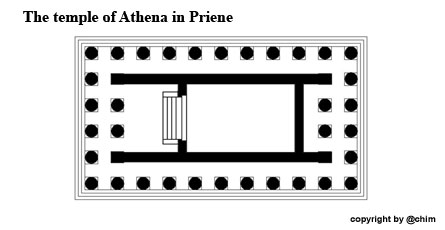 |
|
Ancient temples in Turkey Priene |
||||||||||||||||||||
|
|
|
|||||||||||||||||||
|
||||||||||||||||||||
|
The temple of Athena in Priene is one of the relatively few buildings of Greek antiquity whose architect has survived by name. According to Vitruv (Vitruv (Marcus Vitruvius Pollio) was a Roman architect, engineer and architectural theorist. He lived in the 1st century BC) he was designed by Pytheos, who also worked on the Maussoleion of Halikarnass. Vitruv praised the activity at the temple of Athens as excellent. The temple was part of a larger sanctuary. On the eastern side of the temple terrace was a 12.45 x 6.47 metre altar. The examination of the architectural ornamentation revealed several construction phases, from the beginning in the second half of the 4th century BC to the completion in the earliest Roman imperial period, presumably under Augustus. Due to its mention in Vitruvius, great importance was attached to the temple of Athena and its order. |
||||||||||||||||||||
| Athena | ||||||||||||||||||||
|
Athena or Athene (honorary title: Pallas Athene) is a goddess of Greek mythology. She is the goddess of wisdom, strategy and struggle, of art, craftsmanship and handicraft, as well as the patron goddess and eponym of the Greek city of Athens. She belongs to the twelve Olympic deities, the Olympioi. The Roman goddess Minerva corresponds to her. According to the oldest and most widespread myth version of the descent and birth of Athena, she was a daughter of Zeus and Metis.
Zeus had devoured Metis, who was pregnant with two children, because Uranos and Gaia had prophesied to him that a daughter was Zeus' equal, but a son would overthrow him. When he suffered from great headaches afterwards, Hephaistos broke his head (which he survived as father of the gods) at Zeus' command. |
||||||||||||||||||||
| The history of Priene | ||||||||||||||||||||
|
|
||||||||||||||||||||
|
|
||||||||||||||||||||
|
|
||||||||||||||||||||
|
|
||||||||||||||||||||
|
|
||||||||||||||||||||
|
|
||||||||||||||||||||
|
|
||||||||||||||||||||
|
|
||||||||||||||||||||
| Retaining wall and staircase to the temple terrace | ||||||||||||||||||||
| Photos: @chim | ||||||||||||||||||||
| Translation aid: www.DeepL.com/Translator | ||||||||||||||||||||
| Source: Wikipedia and others | ||||||||||||||||||||
|
|



